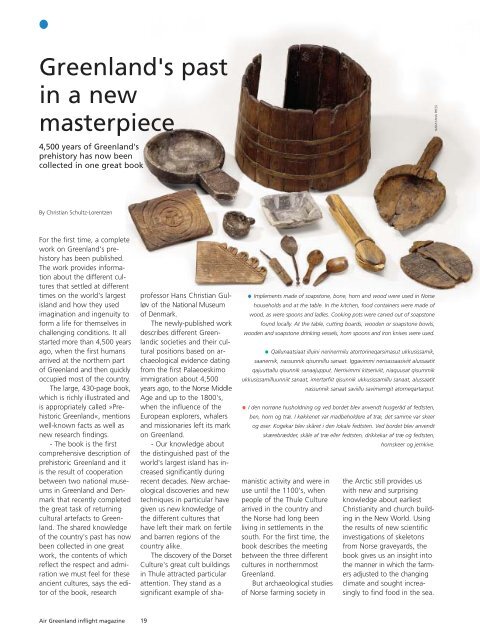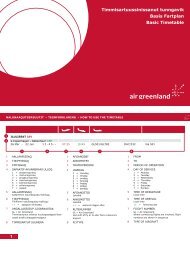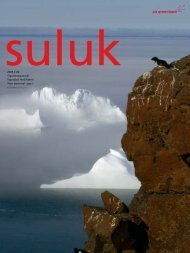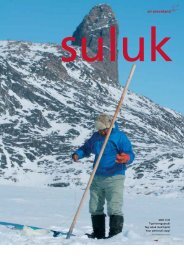Klik her for at se PDF'en - Air Greenland
Klik her for at se PDF'en - Air Greenland
Klik her for at se PDF'en - Air Greenland
You also want an ePaper? Increase the reach of your titles
YUMPU automatically turns print PDFs into web optimized ePapers that Google loves.
●<br />
<strong>Greenland</strong>'s past<br />
in a new<br />
masterpiece<br />
4,500 years of <strong>Greenland</strong>'s<br />
prehistory has now been<br />
collected in one gre<strong>at</strong> book<br />
By Christian Schultz-Lorentzen<br />
For the first time, a complete<br />
work on <strong>Greenland</strong>'s prehistory<br />
has been published.<br />
The work provides in<strong>for</strong>m<strong>at</strong>ion<br />
about the different cultures<br />
th<strong>at</strong> <strong>se</strong>ttled <strong>at</strong> different<br />
times on the world's largest<br />
island and how they u<strong>se</strong>d<br />
imagin<strong>at</strong>ion and ingenuity to<br />
<strong>for</strong>m a life <strong>for</strong> them<strong>se</strong>lves in<br />
challenging conditions. It all<br />
started more than 4,500 years<br />
ago, when the first humans<br />
arrived <strong>at</strong> the nort<strong>her</strong>n part<br />
of <strong>Greenland</strong> and then quickly<br />
occupied most of the country.<br />
The large, 430-page book,<br />
which is richly illustr<strong>at</strong>ed and<br />
is appropri<strong>at</strong>ely called »Prehistoric<br />
<strong>Greenland</strong>«, mentions<br />
well-known facts as well as<br />
new re<strong>se</strong>arch findings.<br />
- The book is the first<br />
comprehensive description of<br />
prehistoric <strong>Greenland</strong> and it<br />
is the result of cooper<strong>at</strong>ion<br />
between two n<strong>at</strong>ional mu<strong>se</strong>ums<br />
in <strong>Greenland</strong> and Denmark<br />
th<strong>at</strong> recently completed<br />
the gre<strong>at</strong> task of returning<br />
cultural artefacts to <strong>Greenland</strong>.<br />
The shared knowledge<br />
of the country's past has now<br />
been collected in one gre<strong>at</strong><br />
work, the contents of which<br />
reflect the respect and admir<strong>at</strong>ion<br />
we must feel <strong>for</strong> the<strong>se</strong><br />
ancient cultures, says the editor<br />
of the book, re<strong>se</strong>arch<br />
<strong>Air</strong> <strong>Greenland</strong> inflight magazine 19<br />
professor Hans Christian Gulløv<br />
of the N<strong>at</strong>ional Mu<strong>se</strong>um<br />
of Denmark.<br />
The newly-published work<br />
describes different <strong>Greenland</strong>ic<br />
societies and their cultural<br />
positions ba<strong>se</strong>d on archaeological<br />
evidence d<strong>at</strong>ing<br />
from the first Palaeoeskimo<br />
immigr<strong>at</strong>ion about 4,500<br />
years ago, to the Nor<strong>se</strong> Middle<br />
Age and up to the 1800's,<br />
when the influence of the<br />
European explorers, whalers<br />
and missionaries left its mark<br />
on <strong>Greenland</strong>.<br />
- Our knowledge about<br />
the distinguished past of the<br />
world's largest island has increa<strong>se</strong>d<br />
significantly during<br />
recent decades. New archaeological<br />
discoveries and new<br />
techniques in particular have<br />
given us new knowledge of<br />
the different cultures th<strong>at</strong><br />
have left their mark on fertile<br />
and barren regions of the<br />
country alike.<br />
The discovery of the Dor<strong>se</strong>t<br />
Culture's gre<strong>at</strong> cult buildings<br />
in Thule <strong>at</strong>tracted particular<br />
<strong>at</strong>tention. They stand as a<br />
significant example of sha-<br />
● Implements made of soapstone, bone, horn and wood were u<strong>se</strong>d in Nor<strong>se</strong><br />
hou<strong>se</strong>holds and <strong>at</strong> the table. In the kitchen, food containers were made of<br />
wood, as were spoons and ladles. Cooking pots were carved out of soapstone<br />
found locally. At the table, cutting boards, wooden or soapstone bowls,<br />
wooden and soapstone drinking ves<strong>se</strong>ls, horn spoons and iron knives were u<strong>se</strong>d.<br />
● Qalluna<strong>at</strong>sia<strong>at</strong> illuini nerinermilu <strong>at</strong>ortorineqarsimasut ukkusissamik,<br />
saanernik, nassunnik qisunnillu sana<strong>at</strong>. Iggavimmi nerisassaasiviit alussa<strong>at</strong>it<br />
qajuuttallu qisunnik sanaajupput. Nerrivimmi kit<strong>se</strong>riviit, niaquus<strong>at</strong> qisummik<br />
ukkusissamilluunniit sana<strong>at</strong>, imertarfiit qisunnik ukkusissamillu sana<strong>at</strong>, alussa<strong>at</strong>it<br />
nassunnik sana<strong>at</strong> saviillu savimerngit <strong>at</strong>orneqartarput.<br />
● I den norrøne husholdning og ved bordet blev anvendt husgeråd af fedtsten,<br />
ben, horn og træ. I køkkenet var madbeholdere af træ, det samme var skeer<br />
og ø<strong>se</strong>r. Kogekar blev skåret i den lokale fedtsten. Ved bordet blev anvendt<br />
skærebrædder, skåle af træ eller fedtsten, drikkekar af træ og fedtsten,<br />
hornskeer og jernkive.<br />
manistic activity and were in<br />
u<strong>se</strong> until the 1100's, when<br />
people of the Thule Culture<br />
arrived in the country and<br />
the Nor<strong>se</strong> had long been<br />
living in <strong>se</strong>ttlements in the<br />
south. For the first time, the<br />
book describes the meeting<br />
between the three different<br />
cultures in nort<strong>her</strong>nmost<br />
<strong>Greenland</strong>.<br />
But archaeological studies<br />
of Nor<strong>se</strong> farming society in<br />
the Arctic still provides us<br />
with new and surprising<br />
knowledge about earliest<br />
Christianity and church building<br />
in the New World. Using<br />
the results of new scientific<br />
investig<strong>at</strong>ions of skeletons<br />
from Nor<strong>se</strong> graveyards, the<br />
book gives us an insight into<br />
the manner in which the farmers<br />
adjusted to the changing<br />
clim<strong>at</strong>e and sought increasingly<br />
to find food in the <strong>se</strong>a.<br />
NARAYANA PRESS











